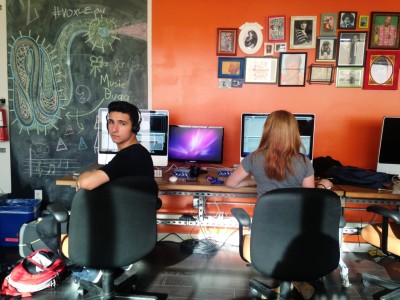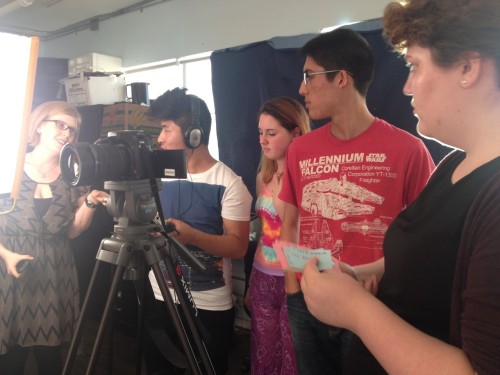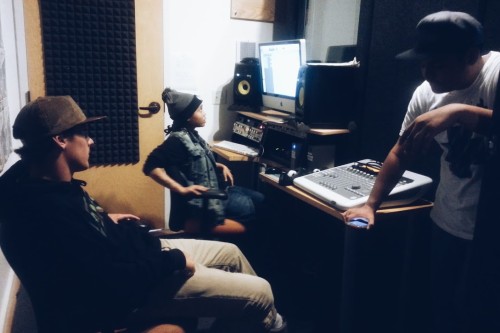This is the eighth in a series of blog posts about Maker Ed’s Open Portfolio Project work during the summer and fall 2014. These posts are also written in conjunction with the Research Briefs being released throughout 2014 and into 2015.
The Bay Area Video Coalition (BAVC), located in the Mission neighborhood of San Francisco, has been inspiring and guiding the community through digital media production for almost 40 years now. Their Next Gen programs, serving predominantly underrepresented youth, provide teens with both the hard and soft skills to pursue their interests and potential careers in digital media production. The Tracks program brings students to BAVC twice a week after school throughout the entire academic year. Each month, special workshops related to public speaking and resume building to field trips and panels for industry exposure (including college campus tours), and the like are also offered to build up the non-technical, leadership skills needed for any future career.
 At the time of our field site visit in September 2014, the Tracks afterschool classes were just starting, with instructors and students mostly focused on getting to know one another and starting the introduction of technical skills. Tracks include classes like G:URL Gamers, Sound Bytes: Beginning Audio, BUMP Records (Advanced Multimedia for Musicians), Reel Life: Beginning Video and The Factory (Advanced teen filmmaking). No matter which track, in each class, students are required to present their end-of-program portfolios at a final showcase and encourage to pitch and complete a paid social action project over the summer.
At the time of our field site visit in September 2014, the Tracks afterschool classes were just starting, with instructors and students mostly focused on getting to know one another and starting the introduction of technical skills. Tracks include classes like G:URL Gamers, Sound Bytes: Beginning Audio, BUMP Records (Advanced Multimedia for Musicians), Reel Life: Beginning Video and The Factory (Advanced teen filmmaking). No matter which track, in each class, students are required to present their end-of-program portfolios at a final showcase and encourage to pitch and complete a paid social action project over the summer.
With so much experience facilitating the design and development of youth portfolios, it was no question that BAVC’s insights are critical to Maker Ed’s Open Portfolio Project. All makers consider the sharing of their work to be a critical component of their work overall, and digital making is no different. What is different — and enlightening — are the perspectives that BAVC’s instructors bring to the conversation. Most of the Next Gen program instructors and TAs are female, a diverse group of talented professionals with backgrounds and expertise not only in youth development but also in the digital media areas they’re teaching. Each spoke to the challenges and approaches of creating and curating their own portfolios of work, all of which inform their students’ processes too. Having qualified women in these roles serves two very important purposes, among others: it situates them as strong leaders and mentors to the youth they teach, and it counters the societal status quo that fields like film, music, and video game design are dominated by men.
Over the years, BAVC instructors and students have experimented with a number of platforms, everything from Pathbrite to WordPress, Behance to wix.com, TUMBLR, CarbonMade, SoundCloud, Bandcamp and Vimeo. Some platforms are more popular than others, some easier to navigate than others, and some are simply better suited for displaying certain types of media, such as audio or video. The instructors, when asked about their own portfolios of work, reflected the diverse platforms, but more importantly, they brought up a few other key considerations that superseded the debate around best software. Those thoughts resonated throughout our conversations, coming through time and time again. They were:
- Youth — and all people — must consider how their identities are presented to the world: for what audience, with what intention, and with what control over their image, reputation, and personal information.
- A portfolio is useful not only for archiving work but also crucial for self-development. It takes skills to build and maintain it; it develops fluency in representing oneself; it shows ability, voice, and work ethic.
When asked why youth should create portfolios, an abundance of thoughts, drawn from personal and professional experiences, surfaced. Instructors called out that, in today’s digital age, it is particularly important to control — and curate — one’s own identity and work for display. Having an online presence is an opportunity to create a brand, build an aesthetic, and contribute work to share with the greater world. These perspectives also allow youth to step beyond the classroom, for their work is important, outside of a grade or a teacher’s judgment. Portfolios are also a way for youth to show off their skills, whether technical skills or soft skills. Portfolios may show a professionalism beyond the norm, even confidence in one’s own work. A single project or artifact might prove that a student has completed something from beginning to end and can demonstrate their process and skillset.
It’s easy to explain why portfolios are important. It’s less easy to actually facilitate the creation of them. The BAVC instructors talked through a number of challenges that they (and the rest of the field) ponder on a daily basis. Finding hosting is difficult, especially when they need portfolio platforms to be accessible, digital, flexible, and free for the youth they’re serving. Platforms need to accommodate different kinds of media; they need to be stable and not disappear when the tech company is bought out; they need to have archival functionality. BAVC often receives calls from past students who ask for an old media file, but a community organization cannot keep every audio or movie clip from every student. In a perfect world, a portfolio should be owned by its creators, be linked across platforms, be able to exhibit a group identity, and even credit the organizations and mentors that contributed to its development.
Lastly, when asked about whether — and how — the process of making should be captured in portfolios, the instructors hesitated. Almost all agreed that the process students go through to reach the final product is crucial. Specifically, one instructor noted that process should be emphasized, if for no other reason than to show that ideas don’t come out fully-formed and perfect. Nonetheless, the instructors debated the best way to show that process. With digital tools and digital media, does it make sense to save versions of UX designs, solely for the purpose of showing process? To someone unfamiliar with filmmaking, will rough cuts reveal something useful? One asked, “When is something just an exercise or actually a portfolio piece?”
We concluded with a half-satisfactory answer: If an important aspect of portfolios is the presentation of work, it is certainly possible to present process with a level of professionalism and sophistication that shows evolution and self-awareness. Students who design and create a portfolio are able to reflect on their own work and become comfortable explaining and showcasing what they do. With growing confidence, they have the opportunity to demonstrate their skillset and insights to peers, mentors, and adults. And those actions increase their advocacy and ability as an entrepreneur, employee, or academic. Portfolios are both for oneself and for the world watching.



Leave a Reply